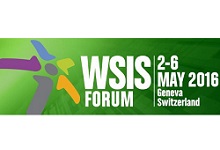ICT Infrastructure: Evolving affordable broadband infrastructure for bringing ICT to all
5 May 2016 15:00h
Event report
[Read more session reports and live updates from the WSIS Forum 2016.]
The panel was moderated by Mr Kemal Huseinovic (Chief, Department of Infrastructure, Enabling Environment and E-Applications, International Telecommunication Union (ITU)), and opened by Mr Yushi Torigoe (Deputy to the Director, Telecommunication Development Bureau, ITU).
Torigoe mentioned that ITU cooperation involves assistance in 4G deployments, disaster risk management, ITU interactive territorial transmission maps, and the forthcoming information about Internet Exchange Points (IXP).
Mr Igor Resende (Deputy Head of Information Society Division at the Ministry for Communications, Brazil), gave the keynote speech on behalf of Mr Maximiliano Martinhão (Vice-Minister for Communications, Brazil).
Resende emphasised Brazil’s pioneering and enthusiasm in the multistakeholder model, citing NETMundial back in 2014, among other initiatives. He indicated that instead of only increasing the coverage of the infrastructure, an increase in the quality of the current Internet services is needed. It also needs to offer foundations for new applications that would benefit citizens, enterprises, and society.
Ms Elizabeth Migwalla (Senior Director Government Affairs – Africa, Qualcomm) pointed out that the Internet is indispensable for integrating into today’s digital economy. The global mobile revolution is a key success factor where harmonisation, standardisation, enabling of the regulatory environment, access to suitable spectrum, and backhaul enhancement are important. She suggested the way forward in providing connections for the unconnected is first to provide ultra-efficient and solar-powered base stations suitable for rural towns. Next, local communities could contribute accommodation and security for the base station and other equipment. And finally, government subsidies could support the effort.
Mr José Costa (Director, Wireless Access Standards, Ericsson Canada) stated that there is a huge difference between Internet adoption in developed countries (89%) and developing countries (39%), giving a great potential to the industry especially when we acknowledge that developing countries represent about 80% of the world’s population. Costa emphasised that the challenge is to develop new ways of thinking, enabling cross-industry cooperation and new business models.
Ms Julia Jasinska (Head of Trade Policy and Regulatory Affairs, EU office-Nokia) highlighted technology expansion possibilities in the connected world. Jasinska indicated that in order to fund ICT development, some things are needed, like revision of taxes, transparent and predicable regulation of the market, the possibility to share resources, facilitated access to governmental buildings, and the creation of new investment models with public-private partnerships.
Mr Colin Langtry (Chief, Radio Communication Study Groups Department, ITU – BR) highlighted that today’s 3G and 4G mobile broadband systems are based on the ITU’s International Mobile Telecommunication (IMT) standard. They are well underway, using the successful partnership of the ITU with the mobile broadband industry and the wide range of stakeholders in the 5G community. He mentioned that the next steps involve continuing the work on the next phases of IMT-2020, with the expected adoption in 2016/2-17.
Mr Chehem Ibrahim Mohamed (Chef de Service Informatique et Responsable du Projet E-santé, Ministère de la Santé – Djibouti) and Mr Abdoulkader Osman Farah (Network Engineer CDMA & Wimax, Djibouti Telecom) gave a presentation on WiMAX network utilisation in the health domain talking about a successful e-health project in Africa.
Mr Bilel Jamoussi (Chief of the Study Groups Department, ITU – Telecommunication Standardisation Bureau (TSB)) emphasised that for technology to be affordable it has to be standards-based, making interoperability an option, avoiding a vendor lock-in, and allowing the community to build networks and solutions based on interoperable standards. He emphasised that the 5G network should support many requirements coming from different directions. In order to provide all those requirements on a single network, the networks have to be programmable.
Mr Desiré Karyabwite (IP Coordinator, ITU – BDT) presented about ITU-BDT is doing in ICT infrastructure, emphasising that mobile is a reality but what about broadband connectivity? Karyabwite presented broadband plans for 2005-2015, citing phases, deployment, adoption, and integration. He considered that the question is not how to implement the network but how to use it in an efficient way.
The panel finished with a presentation by Ms Atsuko Okuda (Chief, ICT and Development Section; ICT and Disaster Risk Reduction Division, United Nations Economic and Social Commission for Asia and the Pacific (UNESCAP)) who mentioned the weight China has in indicators from the Asia region. The differentiated broadband growth in the Asia region is what gives ESCAP an idea of where to intervene. She also presented Asia’s proportionate growth between infrastructure and services.
by Wanda M. Pereza
Related topics
Related event

